Your conveyor belt starts drifting, and within minutes, you're facing another jam that halts the entire production line. What was once a smooth and efficient operation is now hindered by costly downtime, equipment damage, and potential safety hazards.
In manufacturing, distribution, and logistics operations, conveyor belts form the backbone of material handling systems. They move products with the speed and precision that keeps your facility profitable. When tracking goes wrong, the entire workflow suffers.
Mis-tracking is also a profit killer, more just an inconvenience. It can disrupt your entire industrial workflow, rack up substantial repair costs, and create serious safety hazards on the floor.
Key Takeaways
The True Cost of Mis-Tracking: Mis-tracking leads to costly downtime, premature belt replacement, increased maintenance labor, and safety risks. Addressing the root cause of tracking issues saves money and minimizes operational disruptions.
Identify Common Causes of Tracking Problems: Tracking issues can stem from uneven loading, component misalignment, incorrect belt tension, and structural problems. Understanding these causes helps you troubleshoot and resolve issues more effectively before they escalate.
Step-by-Step Solutions to Fix Tracking Issues: This guide walks you through practical steps, including adjusting rollers, checking pulley alignment, fine-tuning belt tension, and implementing advanced solutions like V-guide strips or automatic tracking systems for stubborn problems.
Prevent Future Problems with Routine Maintenance: Regular inspections, proper maintenance schedules, and cleaning routines are essential for keeping your conveyor system in top shape. Catching problems early with routine checks prevents costly breakdowns and ensures smooth operation over the long term.
Why Belt Tracking Problems Cost More Than Just Downtime
A belt that runs off track creates a cascade of problems throughout your operation. The immediate issue is obvious - production stops. But the real costs add up quickly beyond just the halt in output.
Belt edges start wearing out from constant rubbing against guards and side rails. This means premature belt replacement, which isn't cheap when you're dealing with industrial-grade equipment. Material starts spilling onto the floor, creating safety hazards and waste. Your maintenance crew has to stop other work to deal with the emergency.
Meanwhile, equipment downstream either runs empty or backs up with material that can't move through the system. Workers end up manually handling materials around the problem area, which increases the risk of injury.
The worst part is that tracking problems rarely happen just once. If you don't fix the root cause, you'll be dealing with the same issue repeatedly. Each time costs you production time, labor, and equipment wear.
- Production downtime: $500-5,000 per hour, depending on line capacity*
- Premature belt replacement: $2,000-15,000 per belt section*
- Increased maintenance labor: 4-12 hours per incident*
- Material waste and cleanup: Variable based on spillage
*Costs vary significantly based on facility size, product value, belt specifications, and regional labor rates
The Root Causes of Conveyor Belt Tracking Issues
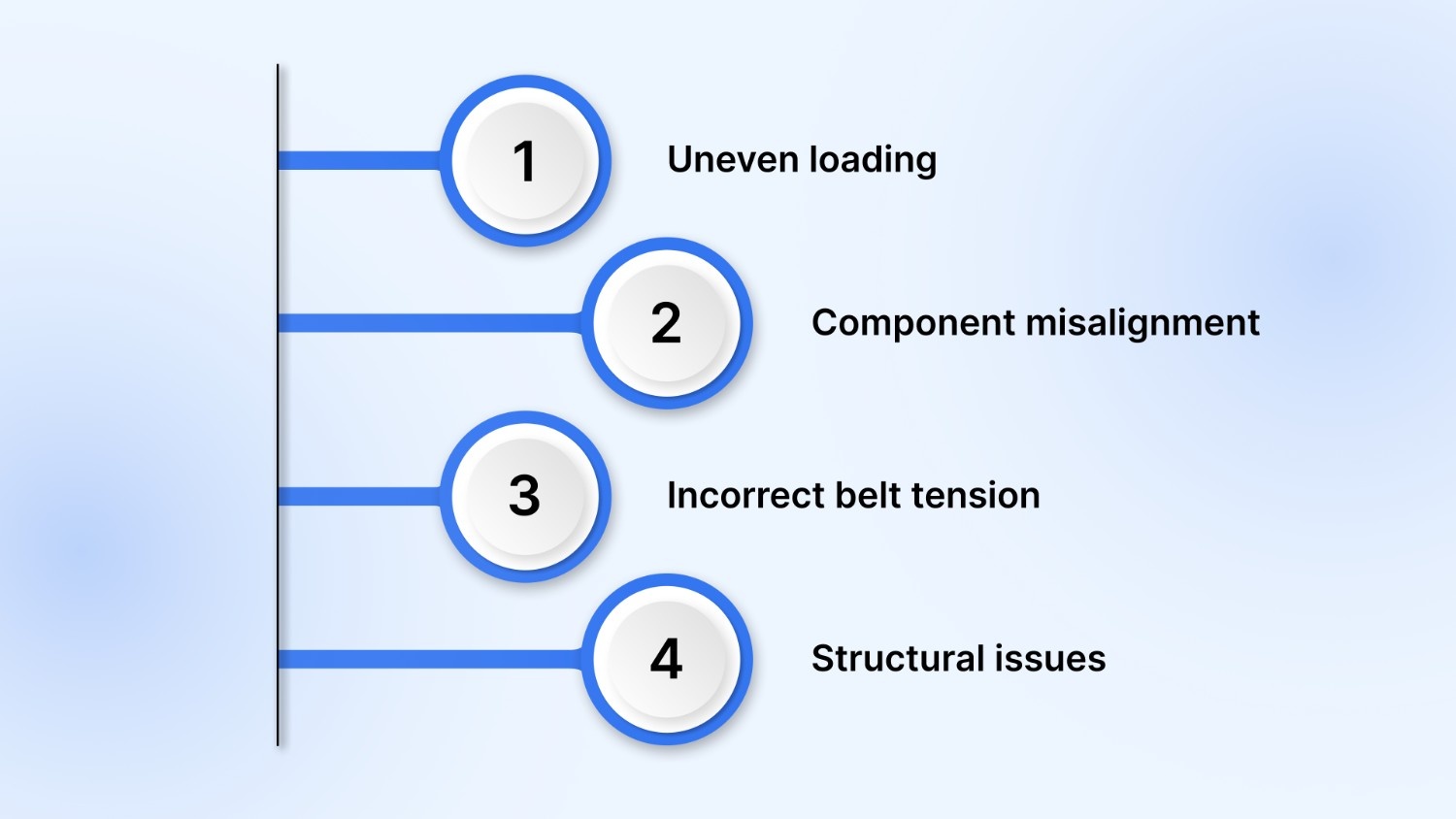
Before jumping into fixes, you need to understand what makes conveyor belts track properly in the first place. A belt naturally wants to run to the highest point of any pulley it wraps around. When everything is aligned correctly, that highest point is dead center.
The four main culprits behind tracking problems are:
- Uneven loading: Material hitting one side of the belt more than the other
- Component misalignment: Pulleys and rollers not positioned correctly
- Incorrect belt tension: Too tight, too loose, or uneven across the width
- Structural issues: Frame problems that throw everything out of alignment
Each of these problems can occur independently or combine with others to create complex tracking challenges. The key is systematic diagnosis to identify which factors are affecting your specific system.
Essential Tools and Equipment for Professional Belt Tracking
Having the right tools makes the difference between a quick fix and hours of guesswork. Professional tracking jobs require more than just basic hand tools.
Basic alignment tools:
- 4-foot construction level (minimum)
- 50-foot tape measure for diagonal measurements
- Standard wrench set for adjustment bolts
- Belt tension gauge (spring-loaded or electronic)
Precision alignment equipment:
- Laser alignment system (highly recommended for critical applications)
- String line setup for long conveyor alignment
- Dial indicators for measuring pulley runout
- Optical square for checking frame geometry
Advanced tracking aids:
- V-guide strips (polyurethane or steel)
- Self-tracking idler assemblies
- Electronic tracking sensors and actuators
- Impact bars and loading skirts
The investment in proper tools pays for itself quickly when you can fix tracking problems in minutes instead of hours.
How to Fix the Uneven Loading Problems of a Conveyor Belt
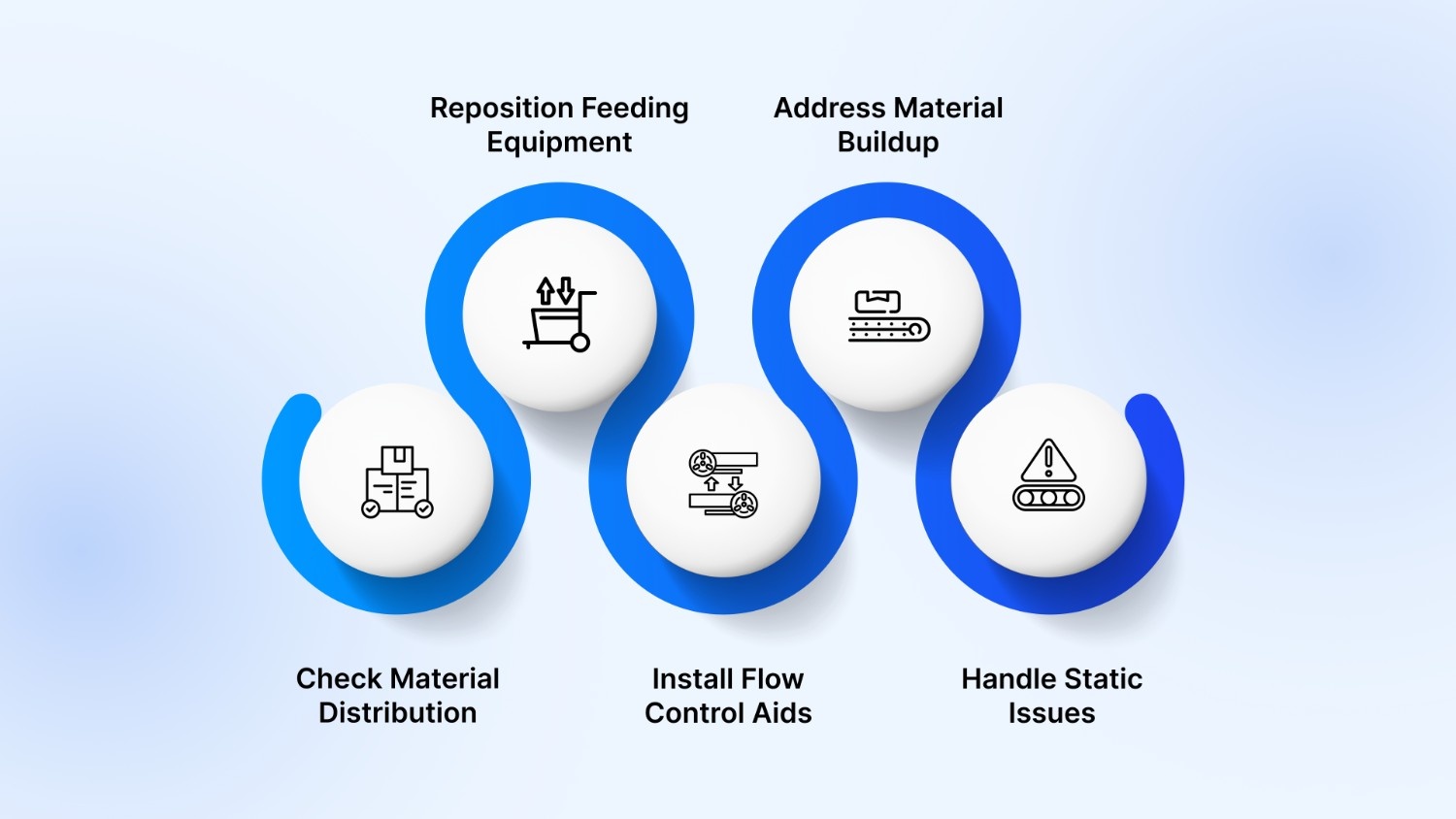
When material doesn't distribute evenly across your belt width, the solution starts at the loading point. Most uneven loading comes from feeding equipment that's shifted out of position or material properties that cause clumping on one side.
Step 1: Check Material Distribution
Start by watching where the material hits your belt during normal operation. It should land centered and spread evenly as the belt moves. If material consistently dumps more on one side, you've identified the source of your tracking problem.
Step 2: Reposition Feeding Equipment
When material loads unevenly, your hoppers or chutes need adjustment. Loosen the mounting hardware and shift the feeding equipment until material flows to the center of the belt. Make small adjustments and test the results before making additional changes.
Specification tip: Most industrial hoppers should center material within ±3 inches of belt centerline for optimal tracking. Positioning requirements vary by material type, belt width, and feed rate
Step 3: Install Flow Control Aids
Sometimes repositioning isn't enough, especially when dealing with sticky or clumping materials. Installing flow aids like impact plates or deflectors helps redirect material flow to achieve better distribution. These are usually simple bolt-on additions that don't require major modifications to your system.
Impact bars should be positioned 6-12 inches below the loading point and angled 15-20 degrees to redirect material flow. Use polyurethane-faced impact bars for abrasive materials to extend component life. Positioning depends on material characteristics, belt speed, and loading height.
Step 4: Address Material Buildup
Material buildup on chutes or feeders often causes loading problems that develop gradually. Sticky materials accumulate on one side of the feeding equipment, redirecting the flow pattern. Regular cleaning prevents this buildup, but you might need mechanical removal for packed material that won't wash off easily.
Install cleanout doors or removable panels on chutes and hoppers to make cleaning easier. Schedule cleaning based on material characteristics—sticky or wet materials may require daily attention, while dry materials might only need weekly cleaning.
Step 5: Handle Static Issues
For materials that cling to one side due to static buildup, anti-static treatments or grounding straps can solve the distribution problem. Fine powders and dry materials are particularly prone to static issues that affect loading patterns.
Humidity control also affects material flow. Very dry environments increase static problems, while high humidity can make materials stick together and load unevenly.
Even if material distribution is perfect, misaligned pulleys and rollers can still cause the belt to wander.
How to Fix Component Alignment Issues

Most tracking problems get solved by properly aligning pulleys and rollers. These components guide your belt, so when they're not positioned correctly, the belt has no choice but to wander off course.
1. Check End Pulley Alignment
Start with your end pulleys since these have the biggest impact on tracking. Use string lines stretched between the pulleys or a laser alignment tool to check if they're parallel to each other and perpendicular to the belt path. Even small misalignments here cause major tracking problems down the line.
Tolerance specification: End pulleys should be parallel within ±0.5mm per meter of conveyor length for optimal tracking. Precision requirements vary by belt type, speed, and application criticality
2. Adjust Misaligned Pulleys
If your pulleys are misaligned, loosen the mounting bolts and adjust the position gradually to correct the misalignment. Make small changes—typically 1-2mm at a time—and check alignment frequently rather than trying to fix everything at once. Large adjustments often overshoot the correct position and create new problems.
Use a systematic approach: Adjust one end first, then the other, checking alignment after each change. This prevents the common mistake of chasing misalignment back and forth between pulleys.
3. Inspect Pulley Crown Condition
Pay close attention to the condition of your pulley crowns. That slight curve across the pulley face—typically 6-10mm crown height for standard industrial belts—helps guide the belt and keep it centered. When crowns wear down or get damaged, they lose their ability to guide the belt properly.
Measure crown height with a straight edge and feeler gauges. Worn or damaged pulleys need replacement rather than adjustment. Attempting to compensate for worn crowns with alignment adjustments usually creates more problems.
4. Adjust Individual Rollers
Individual roller adjustments can solve persistent drift to one side. Slightly angling the roller on the side where the belt drifts helps guide it back toward the center. These adjustments should be minimal—usually just 1-2 degrees maximum. More than that often creates tracking problems in the opposite direction.
Start with the rollers closest to where you first notice tracking problems. Often, adjusting 2-3 strategic rollers fixes the entire system rather than adjusting every roller along the line.
5. Replace Worn Components
Replace any rollers that don't turn freely or show significant wear. Seized bearings create drag that pulls the belt off course, while damaged roller surfaces provide uneven support that affects tracking.
Check bearing condition by spinning rollers by hand. They should turn smoothly without grinding or catching. Replace bearings showing any resistance or noise—these problems only get worse under load.
Correcting Belt Tension Problems
Incorrect belt tension causes more tracking issues than most people realize. Too much tension puts excessive stress on components and can actually worsen tracking problems. Too little tension allows the belt to slip and wander.
Start by measuring your current belt tension with a proper tension gauge. Compare your readings to the manufacturer's specifications for your specific belt and application. Many operations run belts either too tight or too loose because they've never actually measured the tension.
Proper tensioning specifications:
- Fabric belts: 25-35 PIW (pounds per inch width) for most applications
- Steel cord belts: 50-75 PIW depending on load requirements
- Modular plastic belts: Follow the manufacturer's specific torque values
When adjusting tension, make small changes and test the results before making additional adjustments. Increase or decrease tension gradually while watching how the belt responds. Large tension changes can shift the balance of forces in your system and create new tracking problems.
Pay attention to tension distribution across the belt width. Uneven tension from one side to the other pulls the belt sideways just like uneven loading does. Check that your take-up mechanisms are adjusted evenly and that the belt isn't twisted or damaged in ways that create uneven tension.
Monitor how belt tension changes over time. New belts stretch significantly during their first weeks of operation and require periodic adjustments. Older belts may also stretch due to wear or temperature changes, so regular tension checks prevent gradual changes from causing tracking problems.
Addressing Structural and Frame Issues
When your conveyor frame isn't level or square, even perfectly aligned components can't keep the belt tracking properly. Structural problems often develop slowly, making them harder to spot until tracking issues become persistent.
Use a level to check your frame rails both lengthwise and across the width. The frame should be level within the tolerances specified by your equipment manufacturer—typically ±3mm per meter for standard industrial conveyors. Small deviations may not seem significant, but they can cause substantial tracking issues over time.
Check if your frame is still square by measuring diagonally at several points along the conveyor length. Diagonal measurements should be equal if the frame hasn't shifted. Differences greater than 6mm indicate the frame has moved out of square, usually due to foundation settling or loose mounting bolts.
Inspect all mounting connections, especially where the conveyor frame attaches to its foundation. Vibration gradually loosens bolt connections, allowing the frame to shift position. Retightening these connections to proper torque specifications often solves structural alignment problems without major repairs.
Foundation settling requires more extensive correction. You might need to shim mounting points or make adjustments to level the frame properly. Significant settling or structural damage usually requires professional assessment to determine the best repair approach and ensure safety compliance.
Advanced Solutions When Standard Fixes Aren't Enough
Sometimes basic adjustments don't solve persistent tracking problems. In these cases, specialized tracking aids provide additional guidance to keep your belt running straight.
1. V-Guide Strip Systems
V-guide strips are one of the most effective solutions for stubborn tracking issues. These polyurethane or steel strips bolt to the underside of your belt and run in guides mounted to the conveyor frame. They physically prevent the belt from drifting sideways while allowing normal movement along the conveyor path.
Technical specifications: V-guides typically extend 25-50mm below the belt surface and require 5-10mm clearance on each side for proper operation.
Consider v-guides when you have tracking problems despite proper alignment and tension. They're particularly useful for conveyors that handle varying loads, run at high speeds above 200 FPM, or operate in environments where maintaining perfect alignment is difficult.
2. Automatic Tracking Systems
Electronic tracking systems use sensors to detect belt drift and automatically adjust roller positions to bring the belt back into alignment. These systems work well for long conveyors over 100 feet, high-speed applications, or systems that run with minimal supervision.
These systems typically respond to drift within 30-60 seconds and can correct tracking problems before they cause material spillage or belt damage. Electronic tracking systems require more investment than manual solutions, but they can prevent tracking problems before they cause shutdowns.
They're most cost-effective on critical conveyors where downtime costs exceed $1,000 per hour or where consistent tracking is essential for product quality.
Preventing Future Conveyor Belt Tracking Problems
Prevention costs less than repairs and avoids the production losses that come with unexpected shutdowns. Effective prevention focuses on regular inspection, proper maintenance, and understanding your system well enough to spot developing problems.
Set up inspection routines that match your operation's needs. Daily visual checks by operators during normal production can catch obvious tracking changes early. Weekly inspections should include measuring alignment and checking component condition. Monthly deep inspections verify frame alignment, tension accuracy, and structural integrity.
Keep detailed records of inspection results so you can track changes over time. Patterns in your data often reveal when problems are likely to develop and help you schedule maintenance during planned downtime rather than dealing with emergency repairs.
Recommended inspection intervals:
- Daily: Visual tracking check during operation
- Weekly: Component condition and basic alignment
- Monthly: Precision alignment measurements and belt tension
- Quarterly: Frame geometry and structural integrity
Cleanliness plays a bigger role in tracking than most people realize. Material buildup interferes with belt movement and component operation. Focus your cleaning efforts on loading points, transfer areas, and return belt paths where debris typically accumulates.
Train your operators to recognize what normal tracking looks like for your specific system. Every conveyor has its own characteristics, and operators need to know what's normal versus what indicates a developing problem. Early detection allows you to address issues during scheduled maintenance rather than emergency shutdowns.
Common Mistakes That Make Tracking Problems Worse
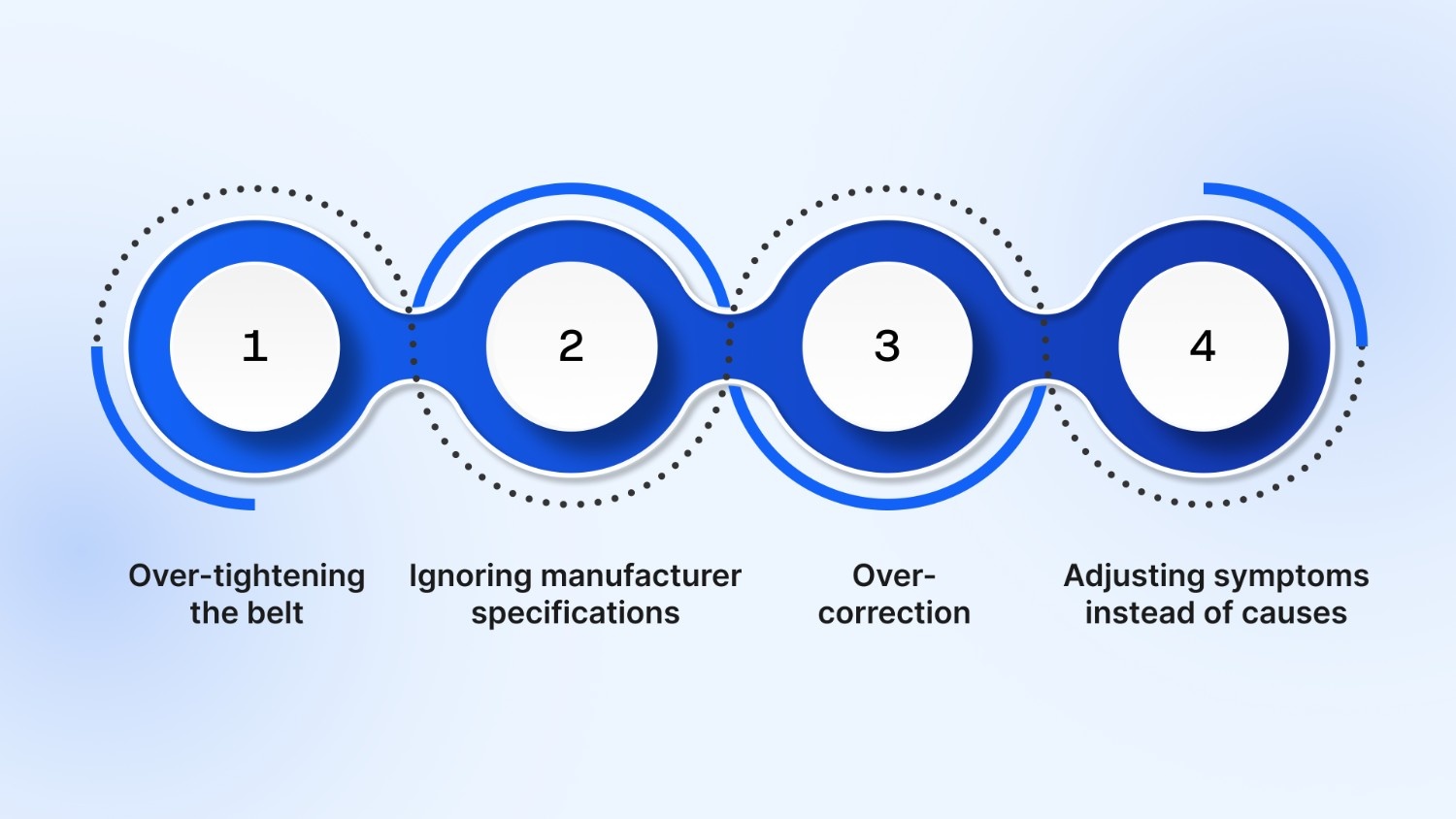
Even experienced maintenance teams can make tracking problems worse by following outdated practices or making assumptions about what needs adjustment.
Over-tightening the belt is probably the most common mistake. Many technicians think more tension automatically improves tracking, but excessive tension actually makes alignment problems worse. It also accelerates bearing wear and increases power consumption. Always measure tension with a gauge rather than guessing.
Ignoring manufacturer specifications leads to problems that seem mysterious but have simple solutions. Belt manufacturers provide specific tension ranges, pulley crown specifications, and alignment tolerances for good reasons. These aren't suggestions—they're engineering requirements for proper operation.
Over-correction happens when you make large adjustments to fix tracking problems quickly. Small, incremental changes work better because they let you see how each adjustment affects belt behavior. Making multiple large adjustments simultaneously often creates new problems that are harder to diagnose.
Adjusting symptoms instead of causes keeps you in a cycle of temporary fixes. If a belt consistently tracks to one side despite proper roller adjustment, the problem might be frame alignment or loading patterns. Fix the underlying issue rather than continuously compensating for it.
Partner with Packaging Experts for Reliable Conveyor Solutions
When tracking problems persist or you're planning system upgrades, working with packaging specialists who understand your exact challenges makes all the difference.
John Maye Manufacturing brings decades of packaging line expertise to help you select and maintain the right conveyor solutions for your operation.
As an authorized distributor in the US for industry-leading manufacturers, including NestaFlex and SocoSystem, John Maye Manufacturing provides complete packaging conveyor solutions tailored to your specific needs.
Their team understands that packaging lines have unique requirements for precision, cleanliness, and reliable tracking that general industrial conveyors can't always meet.
Whether you need immediate tracking problem resolution, system optimization, or are planning new packaging line installations, John Maye Manufacturing combines manufacturer-backed quality with local expertise and support. They ensure you get the right conveyor technology for your application while providing ongoing technical support to keep your lines running efficiently.
Ready to solve your conveyor tracking challenges? Contact John Maye Manufacturing today for expert guidance on your packaging conveyor needs.
With access to multiple manufacturer lines and deep technical knowledge, they can recommend the exact solutions your specific application requires.
Frequently Asked Questions (FAQs)
1. How often should I check my conveyor belt tracking?
A: Daily visual inspections during operation catch most problems early, while weekly detailed checks of alignment and tension prevent major issues. High-speed or critical production lines may need more frequent monitoring. The key is consistency—irregular checking often misses gradual changes that lead to sudden failures.
2. Can I fix tracking problems by adjusting just one roller?
A: Single roller adjustments work for minor drift issues, but systematic problems usually require checking the entire system. Start with end pulleys since they have the most influence on tracking, then work through rollers systematically. Adjusting only one component often just moves the problem to a different location on the belt.
3. Why does my belt track fine when empty but drift under load?
A: Loading changes the forces acting on your belt, revealing alignment problems that aren't obvious when empty. Check your loading point distribution and verify that belt tension is appropriate for your actual operating loads. You may also need to inspect frame deflection under load, as insufficient structural support can cause tracking issues.
4. Should I replace my belt if tracking problems keep recurring?
A: Recurring tracking problems are usually system issues rather than belt problems. Check alignment, tension, and loading before replacing the belt. However, if your belt has a permanent set (curved shape from running off-track), stretched edges, or damaged edges from mis-tracking, replacement may be necessary along with fixing the underlying cause.
5. How do I know if I need V-guides or automatic tracking systems?
A: V-guides work well for conveyors with challenging environments, varying loads, or where manual adjustments are difficult to maintain. Automatic systems make sense for long conveyors, unmanned operations, or applications where tracking precision directly affects product quality. Consider the cost of downtime versus the investment in advanced tracking solutions.
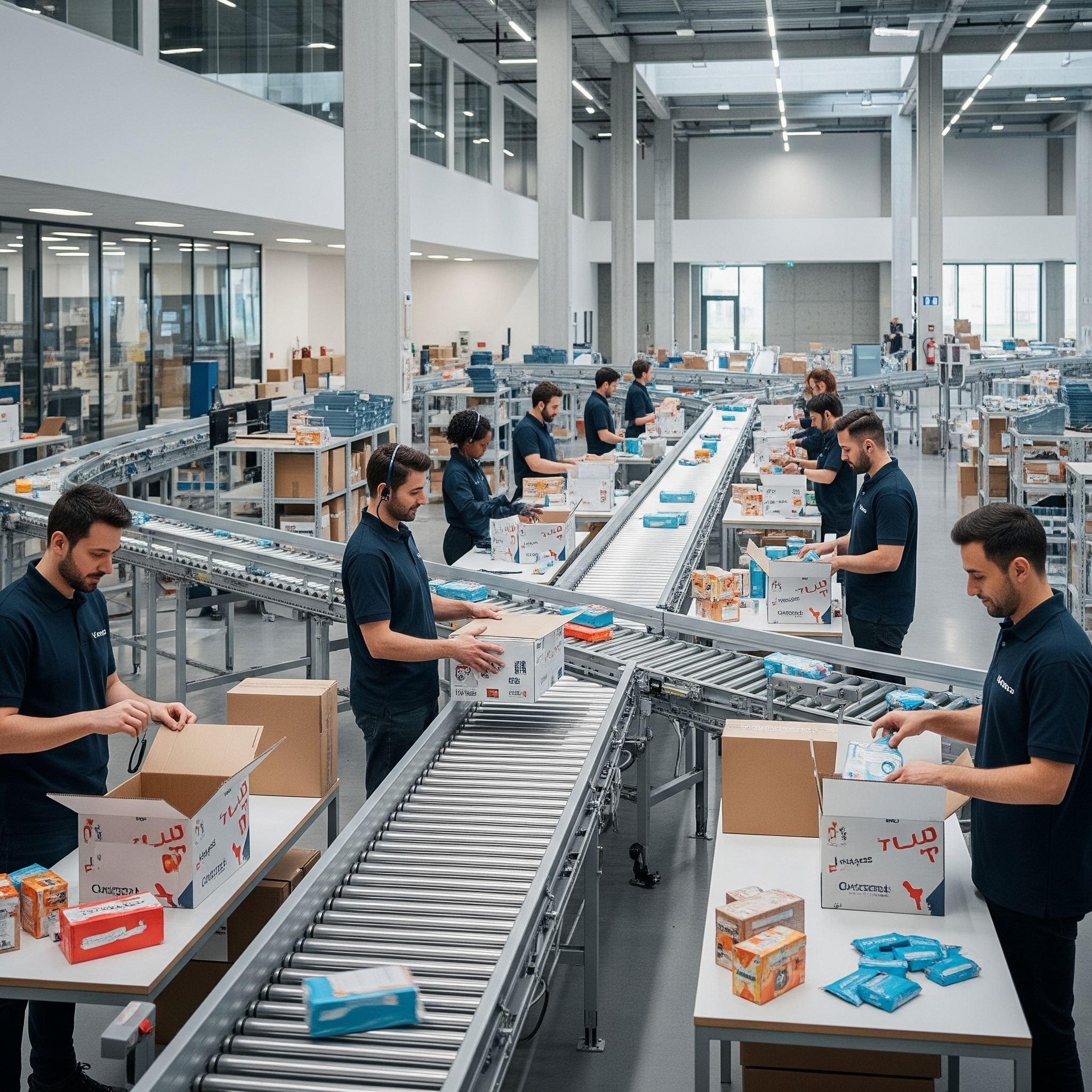
Blogs
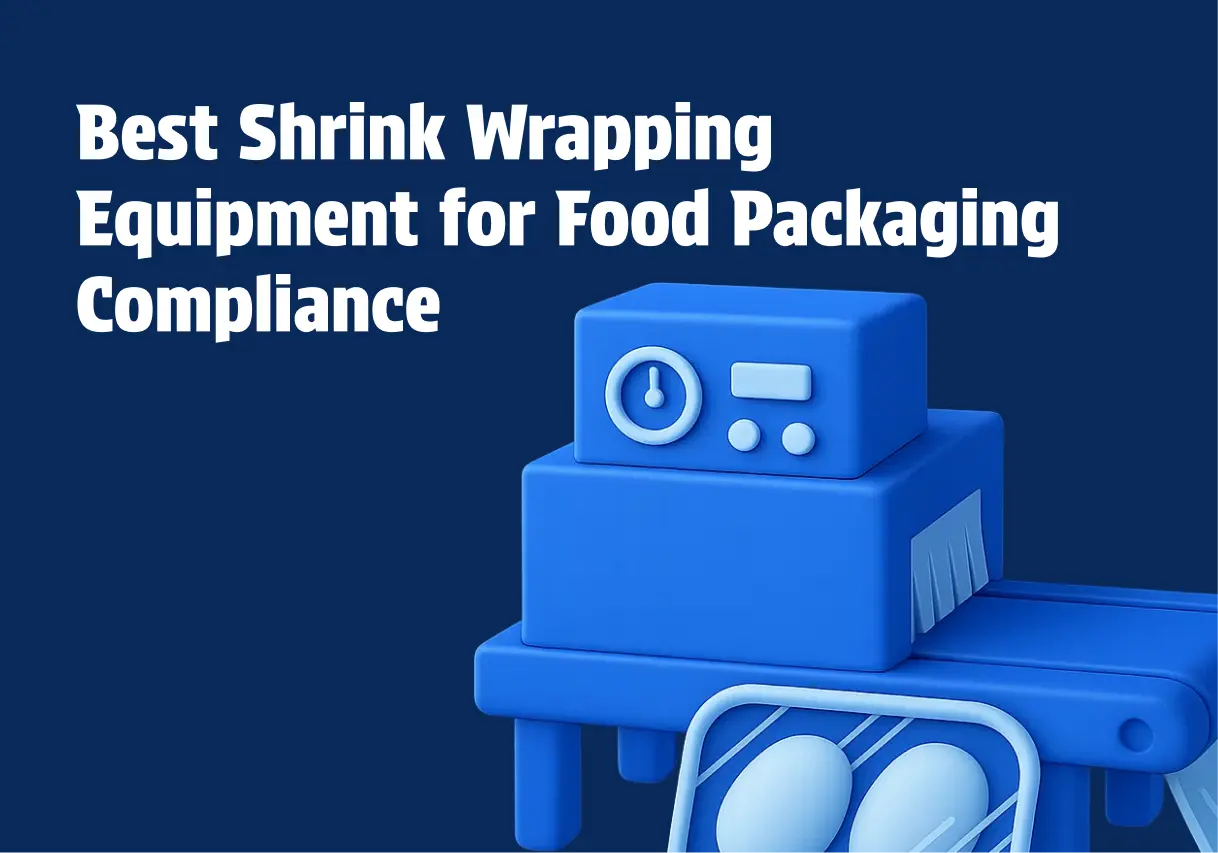
Best Shrink Wrap Machines for Your Business
Discover the best shrink wrapping equipment for food packaging compliance. Conflex offers high automation. Increase efficiency now!

Top Banding Machines for Packaging Solutions
Find top banding machines for small to mid-size packaging lines! Discover flexible automation options and sustainability features. Optimize efficiency today!

Best Pallet Wrapping Machines for Manufacturing Plants 2025
Explore the best pallet wrapping machines for manufacturing plants in 2025. Learn how to choose, compare key models, and reduce wrapping costs.
